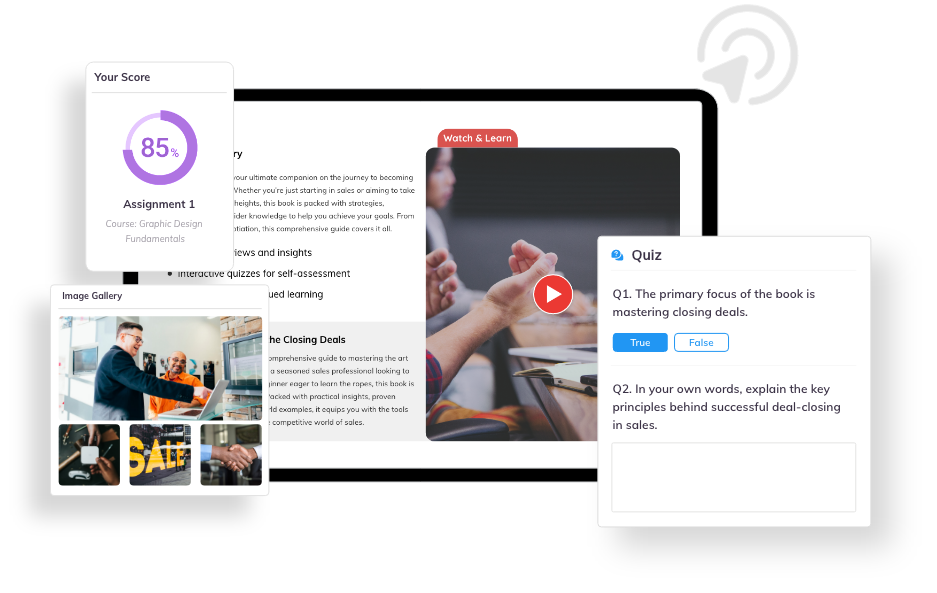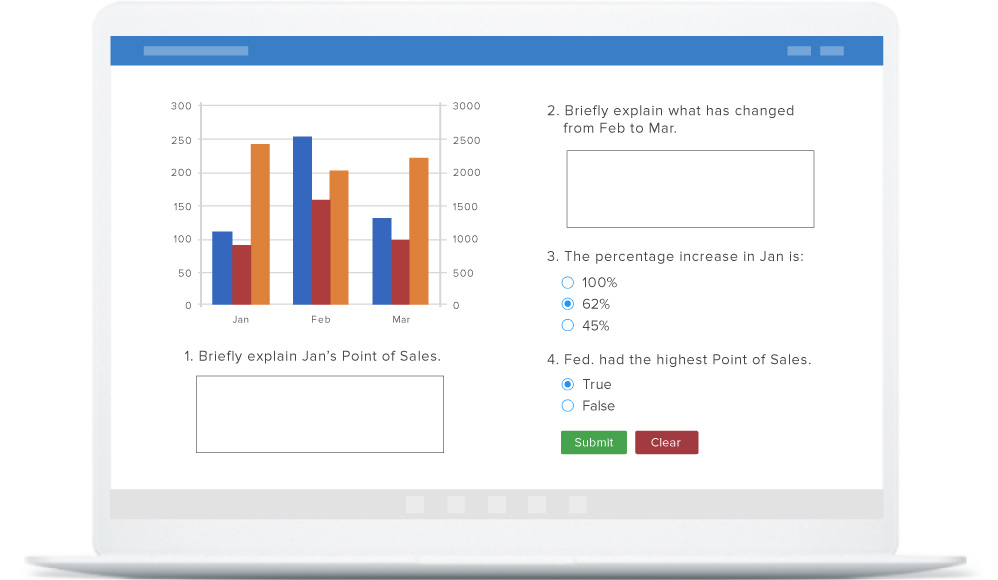Worksheets have been a classroom staple for as long as we can remember, and that’s for good reason. They have always encouraged active learning, reflection, and knowledge assessment. But in today’s digital world, they no longer have to stay static or one-dimensional. They can live inside ebooks and online courses, or as standalone modules, and become interactive experiences that respond to learners’ actions.
By turning worksheets into interactive tools, you transform them from passive exercises into dynamic conversations. Imagine one that provides instant feedback, includes videos and audio, or lets users drag and drop elements to complete a task.
In this guide, we’ll show you how to create engaging interactive worksheets that bring your content to life, whether for classrooms, corporate training, or online learning.
What Makes a Worksheet Interactive?
Worksheets become interactive when they turn users from passive readers into active participants. Unlike traditional PDFs that present information in a one-sided way, interactive worksheets create a two-way dialogue. They achieve this by letting learners click buttons, drag items, match pairs, or enter answers that trigger instant feedback.
Benefits of Using Interactive Worksheets
Using interactive worksheets offers you a lot of benefits in terms of transforming how people learn and engage with your content. Here are some of these perks:
Active Participation
Interactive worksheets don’t just ask for clicks and drags; they encourage learners to think, decide, and apply what they know. This hands-on approach deepens understanding and keeps learners focused for longer periods of time.
Multi-Sensory Learning
We each have a learning style that suits us best. With the help of interactive elements, you can support different learning styles by embedding videos, images, and audio directly into your worksheets. This rich multimedia approach makes complex concepts more accessible and caters to visual, auditory, and kinesthetic learners at the same time.
Immediate Feedback
In a learning context, interactive worksheets can provide instant feedback, showing users if they’re on the right track and explaining why an answer is correct or incorrect. This turns every question into a valuable learning moment, building confidence and correcting misunderstandings in real-time.
Data Insights
Interactive worksheets can give teachers valuable insights into how students learn. They can track completion rates, time spent on each task, and question-by-question performance. These insights reveal patterns (like which concepts need review or which students need extra support) and allow teachers to adjust lessons and provide targeted feedback accordingly.

Why Kotobee Author is the Ideal Tool for Interactive Worksheets
When it comes to building interactive worksheets, you need a tool that gives you flexibility and creative control. That’s what you can find in Kotobee Author, which allows you to design your worksheets exactly the way you want. With a wide range of question types, it helps you design worksheets that can bring your content to life and keep your users actively engaged.
Here are the types of interactive elements you can include in the worksheet:
Multimedia Elements
Include images and audio clips directly into individual questions and answer choices. This helps you create realistic, context-rich scenarios, such as adding photos to multiple-choice questions, including pronunciation audio in language exercises, or attaching diagrams to help explain concepts. This makes learning more engaging and clear for everyone.
Interactive Quizzes
Create different kinds of activities beyond simple multiple-choice. Include matching exercises, drag-and-drop games, or even image hotspots where students answer by clicking on a certain part of a picture. Here’s a list of the question types you can add to your sheet:
- Drag and Drop, which allows readers to sort items, sequence steps, or categorize concepts
- Image Hotspot, in which readers identify components in a diagram or select areas in an image
- Matching related items, like terms and their definitions
- True/False for quick knowledge checks, with customizable labels
- Short Answer with open-ended responses, graded with keyword recognition
- Numeric Answer, for solving math and science problems
Instant Feedback
Providing students with clear feedback is one of the most powerful ways to promote learning. In Kotobee Author, you can add a general explanation for the entire question; this explanation appears after the reader submits their answer. For multiple-choice questions, you can also provide specific feedback for each individual answer choice. This helps your students understand not just what the correct answer is, but why.
With this feature, you can:
- Explain why the answers are correct or incorrect.
- Give unique feedback for each answer choice.
- Choose how scores are shown (a simple score, a detailed report, or no score at all for practice sessions).
- Assign different score weights to questions so that more important ones count for more in the final result.
Progress Tracking
When you save your worksheet as a cloud-based ebook (an online version of your ebook hosted through Kotobee Cloud), you can see how students are interacting with your content. You’ll receive their scores and will be able to track their progress over time. This can help you understand what they’re excelling in and where they may need more support. This feature can also come in handy for compliance training, certified courses, and client assessments.

A Step-by-Step Guide to Building Interactive Worksheets in Kotobee Author
Let’s move from theory to practice. Here is a detailed walkthrough for creating a powerful interactive worksheet from scratch. You can get started by downloading Kotobee Author, which offers a free version to explore its various features.

Step 1: Plan Your Objectives and Structure
Begin by deciding what you want learners to achieve, what skills or knowledge they should demonstrate. Outline your worksheet’s flow accordingly, mixing content with interactive questions. Think about your readers: are they employees, students, or customers? This helps you choose the right difficulty level and question types.
💡Pro tip: Consider starting with an introductory video, followed by knowledge checks, hands-on practice exercises, and a final assessment.
Step 2: Create a New Project and Add Questions
Once you have you’re objectives clear, it’s time to create a new ebook in Kotobee Author and add your content. To insert a question, go to the toolbox on the right-hand side of the screen and click on the Questions button. The Insert/Edit Questions window will appear, showing all the different question types you can choose from.
- Multiple choice (single or multiple answer)
- Drag-and-drop categorization
- Image hotspot identification
- Matching pairs
- True/False with custom labels
- Short answer with keyword recognition
- Numeric response fields
Step 3: Customize the Quizzes and Settings
Fine-tune how learners interact with your worksheet by adjusting its settings. Here’s what you can customize:
- Set scoring options by choosing whether learners see only their score, a detailed report, or no score at all for practice activities.
- Add answer explanations to provide instant feedback after each question.
- Assign different score weights to make certain questions count more than others.
- Enable email responses to receive completed worksheets directly in your inbox.
- Customize labels and design elements to match your brand or course style.
- Add images or audio to any question or answer choice (for MCQs) to make them more engaging and accessible.
Step 4: Preview the Worksheet
Use the preview function to test your worksheet from a user’s perspective. Check that all the interactive elements are working, the media elements are displayed properly, and the feedback appears as planned. Also, make sure that the instructions are clear and the difficulty level is appropriate. This is your chance to catch any issues before sharing with others.
Step 5: Share with Your Students
Kotobee gives you multiple options when it comes to exporting and sharing your worksheets with your students. For instance, you can:
- Export it as an EPUB for students to self-study and practice answering questions independently, without the instructors tracking their scores.
- Publish it to Kotobee Cloud to collect learner responses and view their scores and progress.
- Create a SCORM package to integrate your worksheet with an LMS such as Moodle, Blackboard, or Edmodo. The LMS will automatically record learners’ answers, scores, and completion data in its gradebook.

Tips and Best Practices
- Don’t present a large block of text followed by 20 questions. Instead, break the content into small, manageable “chunks”, with a few related questions after each. This improves comprehension and reduces the mental load for your students.
- Use high-contrast colors for text and backgrounds to prioritize accessibility. You should also provide a text transcript for any audio content.
Important read: Ebook Accessibility: Why and How to Optimize Your Ebook for All Readers
- As you build a library of questions, use the “Add to Question Bank” feature, which enables you to reuse questions, rather than typing them over again. This allows you to quickly assemble new worksheets by pulling from a screened pool of questions, ensuring consistency and saving time.
- Use specific, action-oriented language for instructions, like “Drag each step into the correct order.”
- Create a balance in difficulty levels. A worksheet that is too easy is boring; one that is too hard is discouraging. Mix question types and difficulties to create a flow that builds confidence but is still challenging to the reader.
- Add multimedia and interactive elements whenever possible to make the worksheet more engaging and accessible. This can include images, video, and audio, or even ebook apps and mini games.
Interactive Worksheet Example
Now that you’ve seen how to build an interactive worksheet step by step, it’s time to see how they actually work. We’ve created a sample interactive worksheet using Kotobee Author that showcases different question types and feedback options, including multimedia and instant feedback.
Preview the Interactive Worksheet
After trying the sample, open Kotobee Author’s free version and follow the same steps to start building your own interactive worksheet.
Conclusion
You now have a clear path for transforming static worksheets into dynamic, interactive experiences using Kotobee Author. From planning your objectives to sharing the final product, each step is designed to help you create more effective learning materials. Whether you’re training employees, teaching students, or engaging customers, interactive worksheets make learning more memorable and effective.
Remember, the journey from passive to active learning is simpler than it seems. Start with clear goals, experiment with different question types, and watch as your content comes alive with instant feedback and multimedia elements.
.
Read More
Top 10 Interactive Ebook Apps for Children’s Ebooks
8 Interactive Teaching Strategies Every Teacher Should Try
How to Create an Interactive Online Course in Just 5 Easy Steps

